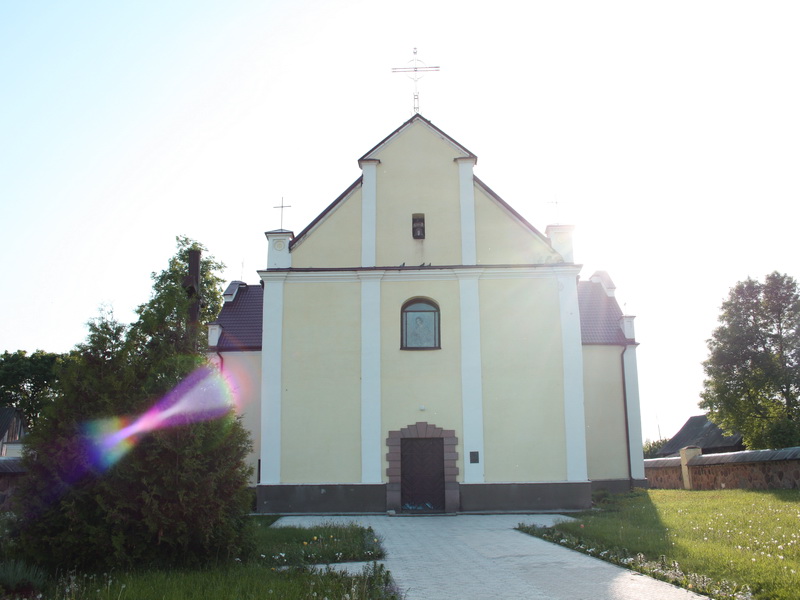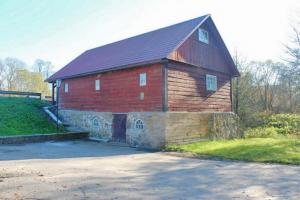From Calvinism to Catholicism
Initially, the temple was built by Protestant Calvinists at the request of the Soltan noble family, who owned Zhodishki in the early 17th century. However, after the ownership of the settlement changed, the temple was transferred to Catholics and rebuilt in accordance with Catholic architectural traditions. As a result of this transition, the church acquired a new appearance while retaining traces of its original history.
Architectural Features of the Church
Zhodishki Church of the Holy Trinity combines elements of Renaissance and Baroque, reflecting its complex history. Originally constructed as a Calvinist temple between 1600 and 1612, it was later transformed into a Catholic church, which influenced its architectural style. The facade of the building is strict and minimalist, decorated with pilasters and niches, while the entrance portal lacks excessive ornamentation typical of Protestant churches.
After the church became Catholic, its interior was enriched with Baroque elements, including carved altars, gilded decorations, and frescoes. The spacious interior with high vaulted ceilings creates a sense of grandeur. Built of brick and reinforced with massive buttresses, the church has retained its monumental appearance and remains an important architectural landmark of Belarus.
History of Zhodishki Church of the Holy Trinity
Zhodishki Church of the Holy Trinity is a unique architectural monument associated with the history of noble families, monastic orders, and the cultural heritage of Belarus.
The church was built in the 18th century at the initiative of the influential Sapieha family. At that time, Zhodishki was under their ownership, and they sought to embellish their estate with a grand temple. A monastery of the Piarist order – known for its educational and missionary work – was established at the church. The monastery provided schooling for noble children, contributing to the development of science and culture in the region.
After the partitions of the Polish-Lithuanian Commonwealth and the incorporation of these lands into the Russian Empire, the fate of the church changed. In the 19th century, it underwent renovations, but during the Soviet period, like many religious sites, it was closed and suffered damage. However, after Belarus regained independence, the church was returned to the faithful and remains an active Catholic place of worship, preserving the spirit of its centuries-old history.
Legends and Folklore
Several local legends are associated with the Zhodishki Church, passed down through generations.
The Nobleman Buried Beneath the Altar
According to legend, a member of the Sapieha family was buried directly beneath the church’s main altar. It is believed that he did this to secure eternal blessing. Some say that on quiet nights, footsteps or whispers can be heard in the church, as if the spirit of the deceased still lingers within its walls.
The Disappearing Treasure
Local villagers tell a story that before the church was closed during Soviet times, priests tried to hide sacred relics and church treasures. According to one version, these valuable artifacts were walled up inside the church or hidden beneath the floor. Although archaeologists have found no evidence to confirm this theory, treasure hunters continue to search for hidden caches.
The Miraculous Healing
Believers claim that one of the ancient icons in the church possesses miraculous healing powers. In the early 20th century, a woman suffering from a serious illness reportedly had a vision of the Virgin Mary, who instructed her to visit the church and pray before the icon. The woman followed this guidance, and soon her illness disappeared. This legend continues to be passed among the faithful, and the church remains a place of prayer and hope.
Excursions with a Visit to Zhodishki Church of the Holy Trinity
An excursion from Minsk with a visit to Zhodishki Church of the Holy Trinity will be of interest to those who appreciate history and architecture. During the excursion, you will learn about the construction of the church, its architectural features, and the legends associated with it. There will also be an opportunity to explore the church’s interior and learn about its role in the region’s development.
It is recommended to book the excursion in advance by selecting a convenient date and time on the website. Zhodishki Church of the Holy Trinity can be visited as part of the excursion Grinding the Millstones: Zaslavl – Zhodishki.

